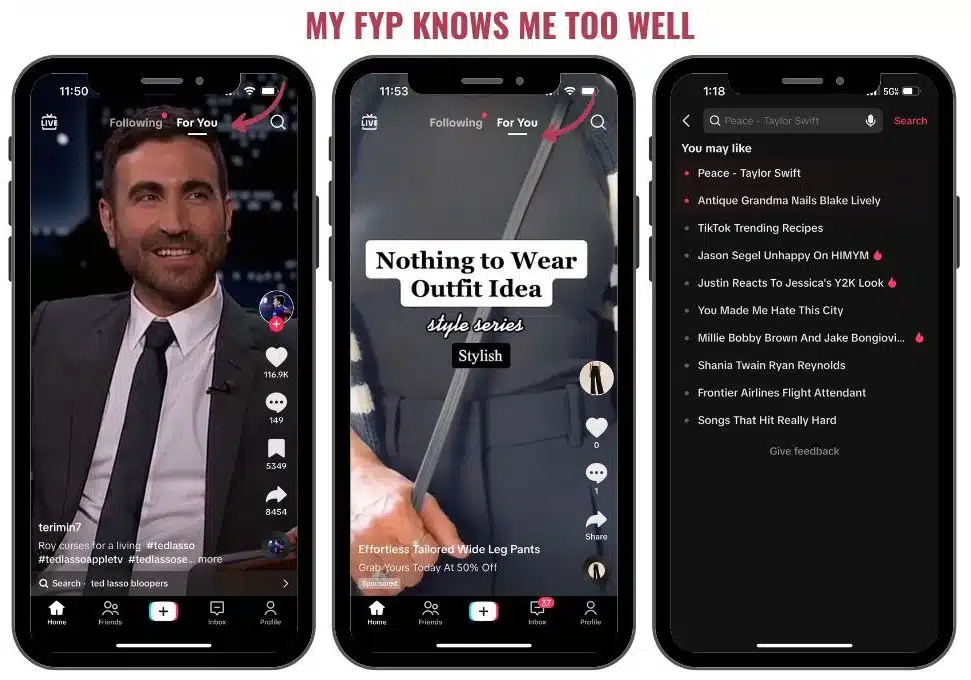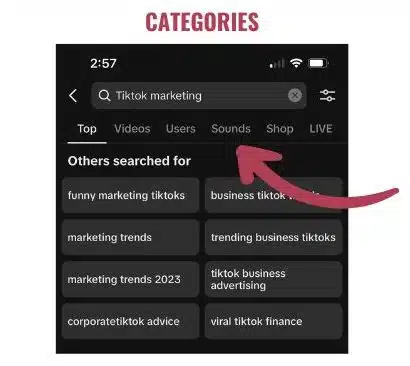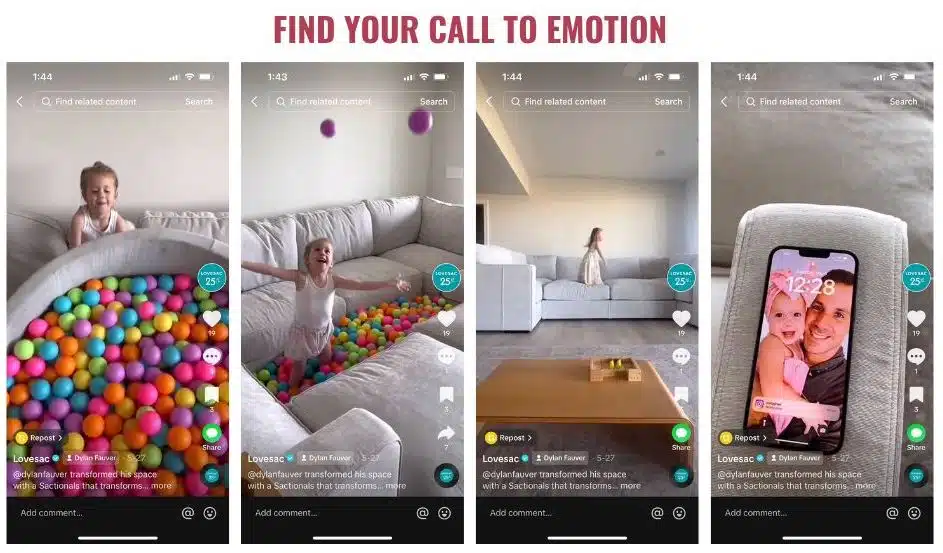The short visuals paired with instant verification via comments have positioned TikTok as a challenger in the search industry in a way no other social platform has been able to achieve.
Today’s headlines may focus on how Gen Z uses TikTok as a search engine, but it’s not limited to Gen Z. Millennials are TikToking. Even my mom – a boomer – is on board, and your mom probably is, too.
As a brand, you have an audience on TikTok regardless of how you define them. This might be why you created a TikTok account for your company or brand.
Now what?
What we know about the TikTok algorithm
Just like Google, TikTok has an algorithm that determines when and where your content appears or “ranks” organically. In the app, there are three main video feeds:
- The For You page (FYP) shows trending videos on TikTok based on your interests, likes, watch time, and engagement.
- The Following feed shows videos from the people you follow.
- The search feature, where you can search users, videos, sounds, LIVEs, and hashtags.
Dig deeper: How the TikTok algorithm works: Everything you need to know
The For You page
The For You page is the homepage when users open the app – it’s the first thing they see.
This personalized feed is the main source for content discovery in the app, meaning this is the priority for “ranking” on TikTok.
No two FYPs are the same; in my experience, TikTok’s FYP knows you better than you know yourself.


The Following feed
While ranking factors are essentially the same across each feed, the emphasis is largely on optimizing for the FYP, as TikTok has shared that 97% of video views are known to come from For You pages.
That said, the Following feed can offer valuable audience insights on what is arguably a more captive audience.
By using TikTok Analytics within Creator Tools, you can evaluate which videos bring in followers and how your existing audience interacts and engages with your content.
TikTok search capabilities
TikTok’s indexing and ranking capabilities are insanely advanced. They are picking up on everything, even things unsaid. So be sure to take full advantage of every feature they offer.
As one Twitter user demonstrated, the app can produce relevant and accurate search results even if the keywords a user is searching for are not actually in the caption. Or the hashtags. Or even verbally stated in the video.


Get the daily newsletter search marketers rely on.
How to make your TikTok videos discoverable
With the right approach, you can grow your brand awareness and increase reach on TikTok with a lower investment than traditional search engines. Here are some tips to get there.
Create content people are looking for
Much like you would approach keyword research to inform your website’s title tags, content, and next blog post, you should do keyword research to help determine what TikTok content to create.
Start by using the search function in the app. The first screen will show you a combination of what’s trending and content they deem relevant for you based on your history and engagement.
From there, search for a keyword from your niche – not too broad, but not too specific either.
Put yourself in your audience’s shoes and consider what they may be searching for on TikTok related to your business.
Then scroll down the page and check out the “Others searched for” section. This is a treasure trove of relevant queries users are already searching for.
These are the topics to use as your theme or “hook” when creating content. Then, rinse and repeat until you have a library of discoverable and shareable content ideas.


Don’t forget to explore the other search tabs along the top of your app as well for even more related content and ideas – Videos, Users, Sounds, LIVE, Places, and Hashtags.


Users will give you a solid list of other accounts that create content related to what you are looking for. This is a great resource to see what people are already doing and how it’s performing.
Sounds and Hashtags will also help when it comes to the next step, optimizing your video content.
Create content that ranks
What you need to ensure your audience has the ability to discover your brand on TikTok isn’t a video for each new trend, though that doesn’t exactly hurt!
You need to optimize every piece of content you create for the way people search on TikTok.
Of the three main ranking factors listed above (user interaction, video information, and account settings), there is only one that brands and creators can directly control: video information.
The video information category of TikTok includes the following:
Descriptions
As of late 2022, TikTok video descriptions have a character limit of 2,200 (compared to the previous 300-character limit).
This expansion was a big win for creators, allowing more space for describing your video and, ultimately, providing more opportunities for discovery.
This was also a big step for TikTok to further its goal of becoming a search engine. So use this real estate wisely.
Clearly and succinctly describe your video content, use the key phrases people are searching for based on your keyword research, use hashtags, and don’t forget to mention your brand name.
Hashtags
Much like other social platforms, hashtags on TikTok help describe and categorize videos. Users also often search for and discover new content based on hashtags.
Adding the right hashtags to your video can help you surface on more FYPs and gain more followers.
Be sure to use a mix of popular, niche, and branded hashtags. Three to five hashtags is considered ideal.
Captions
Make your video accessible and improve engagement with captions on TikTok. Auto captions are available to translate speech in your video automatically.
Your cover image is important, too. Be sure to use text overlay to showcase what the video is all about.
Effects
TikTok Effects and Filters are used to customize videos and add details, very similarly to Instagram or Snapchat filters.
These are great for added customization and include everything from a Green Screen background to Time Warp effects.
As with all things TikTok, you can utilize trending effects for greater discoverability.
Sounds
TikTok has an expansive library of sounds and songs; this is another way people search. Using trending sounds is a great avenue for getting your content in front of new viewers.
There are a ton of accounts dedicated to sharing trending audio every week. Using these will give each post the potential to extend your reach beyond those who already follow you.
Playlists
Analogous to the YouTube feature, playlists on TikTok allow you to create a collection of your videos. This makes it easy for viewers to watch videos similar to those they’ve already enjoyed. And, of course, it is another opportunity to provide additional contextual relevance for search.
Advanced tips
Beyond the basics of video information, there are a few more important elements to consider for creating content that ranks on TikTok:
Trends
TikTok’s Trend Discovery Tool is also a great resource for identifying trends, although it is not available in the app itself.
When searching for trending sounds, sometimes a sound has already been trending for a while and has a ton of videos related to it.
Check the top videos under that audio and see how dated they are and how recent the comments are.
Try to utilize audios that have videos with comments from the past week.
Any audio with under 10-20,000 videos plus recent comments is going to be more of a breakout trend than sounds with over 50,000 videos.
Branded hashtags
Make the most of your hashtags by developing a branded hashtag. A branded hashtag is a great way to improve awareness and recognition, as well as promote user-generated content.
Not every branded hashtag has to be centered around a hashtag challenge, either.
Just make sure your hashtag is easy for your audience to remember and spell, making it easier for them to engage with you.
Frequency
One of the most common questions is, “How often should brands post on TikTok?”
Keep in mind quality is more important than quantity. However, TikTok does reward consistency. TikTok for Business recommends an “always-on” strategy, posting 1-4 times per day.
When it comes to brand accounts, very few are actually posting that often. Still, there is no hard rule when it comes to how often your brand should be posting.
That’s dependent on everything from your industry and audience, to your team’s bandwidth. So plan ahead as much as possible, but also remember to be agile and reactive.
TikTok videos across traditional search engines
Search engines crawl and index TikTok, much like Twitter and Instagram.
So by following tried and true SEO best practices regarding TikTok content, your videos are more likely to rank in traditional SERPs on Google, Bing and beyond.
For the right queries, Google will display a short video carousel pulling in TikTok videos. Google uses context clues from your descriptions, captions, hashtags, sounds, etc. (Bing has a similar feature.)
For some queries, Google will pull individual videos from TikTok, using the descriptions and hashtags you painstakingly researched and wrote based on search trends directly in the SERPs, much like metadata.


The prevalence of TikTok videos appearing in Google search results is only going to grow.
As recently as last month, Google announced updates coming to the search results pages that include AI-generated follow-up questions based on queries and integrated TikTok videos.
Create content that builds a connection
Whether it’s BookTok, SwiftTok, PlantTok, or something completely different, there is a community out there that will appreciate what you have to offer.
But it’s not enough to just create videos people are searching for and add a trending sound.
People come to TikTok looking for candor and authenticity, so you need to embody that with your content strategy. You have to create amazing content around your niche.
And then you have to actually offer something valuable, solve a problem, or answer a question.
Much as Google considers E-E-A-T, TikTok is looking for consistency from creators showcasing expertise.
The more often you post on your themes and the more engagement that content gets, the more the algorithm will be able to serve your content to the right audience.
Find your call to emotion
TikTok is about more than just jumping on trends and producing video content. It’s your brand story brought to life visually. Not every piece of content needs to bring together what your customers want and need.
You must think beyond a call to action to drive engagement off the app. We all know social media is not a direct response medium.
So if you’re doing it right, you’re not worried about a call to action. You should be focused on a call to emotion. You have to make your audience feel.
Feel a connection with your brand. Feel joy and excitement.


Remember, we’re all learning together
The most important thing you can do when it comes to TikTok is be agile.
Set goals, test new things, use the latest sounds, participate in trends, and track your progress.
Keep these things in mind to create an experience that drives discovery and connection:
- The algorithm prioritizes regular posters, so the more active you are, the more activity you see.
- Create content that people are already looking for, and be sure to optimize it to get eyes on it in the app and beyond.
- TikTok Trends may have short lifespans, but they’re worth it.
- A Call to Emotion is the best way to show authenticity and make your audience feel a connection.
And it’s worth saying, TikTok isn’t for everyone or every brand, so don’t force it. The audience can tell.
But with over a billion active users, the potential reach is limitless… if you do it right.
Contributing authors are invited to create content for Search Engine Land and are chosen for their expertise and contribution to the search community. Our contributors work under the oversight of the editorial staff and contributions are checked for quality and relevance to our readers. The opinions they express are their own.



